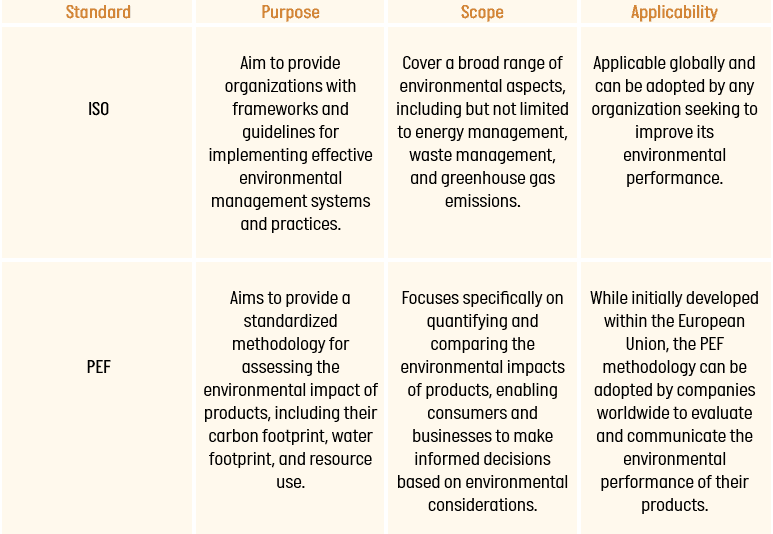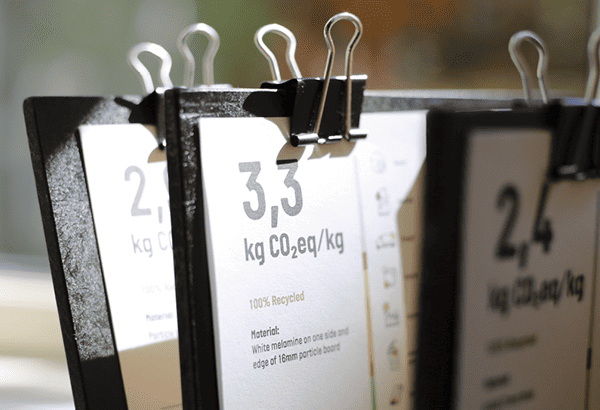
Some organisations find themselves in doubt about the advantages or even relevance of PEF when they already are certified in ISO 14001 (Environmental Management systems) or follow the ISO 14040 standards on Life Cycle Assessment.
Therefore, we have taken it upon ourselves to enlighten you about the differences and similarities of the two standards.
The mountain and the different paths
First a little metaphor. Imagine you are climbing a mountain. At the foot of the mountain, many people are about to start their hiking. In that lower part of the mountain, there is a lot of different routes, which are easily accessible to most hikers. This part of the mountain resembles the ISO standards. Data requirements are low – the hikers do not need to bring a lot of hiking equipment. The different routes stand for the many ways in which ISO-compliant LCAs can be conducted. It is up to the practitioner to decide which route to choose. At the same time, ISO builds a strong foundation without which PEF wouldn’t likely exist.
On the next third of the mountain, there are fewer and more challenging paths. They require more experience and greater expertise. More advanced equipment and preparation is needed. This part of the mountain is the PEF standard. The fewer paths resemble stricter rules that need to be followed for a study to be PEF compliant. The practitioner is less free in his/her choice of model. The advanced equipment and greater preparation hint at the greater detail of information needed to compile PEF-compliant datasets. PEF studies provide a better overview of the system studies and make comparisons between studies easier and more straightforward. Just like you get a better overview of your surroundings and neighbouring mountains the higher up you hike.
The top of the mountain only has one or a few routes. From here, your overview and transparency are complete. The top of the mountain represents PEFCR – Product Environmental Footprint Category Rules. These are specific LCA rules that apply to a specific product category. It is the goal of the EU to develop a PEFCR for all product categories, and right now, they are working on a PEFCR for furniture.
We at Målbar are part of the EU Data Working Group and follow the process closely to take the opportunity to comment and give recommendations. We strive to always stay updated.
ISO and PEF – technical similarities and differences
ISO standards and the European Commission‘s Product Environmental Footprint (PEF) standard fundamentally serve different purposes. However, they share similarities in their approach to environmental management.
ISO – voluntary company standards
ISO – which stands for International Organization for Standards – develops and publishes voluntary international standards covering various aspects of quality, safety, and environmental management. ISO standards related to environmental management include ISO 14001 (Environmental Management Systems) and ISO 14040 series (Life Cycle Assessment).
Environmental Management (ISO 14001) provides organisations with a framework for environmental management systems (EMS), helping them to reduce their environmental impact and comply with environmental regulations.
Becoming ISO 14001 certified involves several steps, including preparation, implementation, and external assessment.
ISO 14040 is not a certification standard. Rather, it is a guideline standard that specifies the principles and framework for conducting life cycle assessment (LCA) studies. Therefore, organisations cannot become “ISO 14040 certified.”
PEF – how to measure the environmental impact of goods
PEF is a methodological framework developed by the European Commission to measure and communicate the environmental performance of products throughout their life cycle. The advantages of PEF cover several areas:
- Environmental Impact Assessment: The PEF standard allows companies to assess the environmental impact of their products throughout their life cycle, from raw material extraction to End-of-Life disposal.
- Product Design and Development: Companies can use PEF to optimise product design and development processes to minimise environmental impacts, such as reducing energy consumption, greenhouse gas emissions, and resource depletion.
- Supply Chain Management: PEF helps companies evaluate the environmental performance of their supply chain and make informed decisions about sourcing and procurement to reduce overall environmental footprint.
- Consumer Information: PEF enables companies to provide transparent and reliable environmental information to consumers, helping them make more climate-reflected purchasing decisions.
- Policy Development: Policymakers can use PEF data to develop and implement regulations and policies aimed at promoting climate-reflected consumption and production patterns at both the national and international levels.
So how do the two standards differ?

PEF and ISO are similar in their methodological approach because they both utilise LCA methodologies to evaluate environmental impacts throughout the life cycle of products.
Building on ISO with PEF
Implementing the European Commission’s Product Environmental Footprint standard in addition to being ISO 14001 certified and having implemented ISO 14040 can offer several benefits and serve specific purposes:
- Enhanced transparency and credibility: While ISO 14001 and ISO 14040 focus on environmental management systems and LCA methodology, the PEF standard provides a specific framework for assessing the environmental performance of products. By implementing PEF, organisations can enhance transparency and credibility by demonstrating commitment to measuring and disclosing the environmental impacts of products in a standardised manner.
- Alignment with european regulations: If your organisation operates in or exports to the European Union (EU), compliance with the PEF standard can help ensure alignment with EU regulations and requirements related to environmental performance and sustainability reporting.
- Market access and competitiveness: Some markets and customers may require or prefer products with verified environmental performance data. By implementing PEF, your organisation can position itself as a leader within climate data and gain competitive advantages.
- Product innovation and optimisation: PEF can assist you in identifying opportunities for product innovation and optimisation, such as reducing environmental impacts across the product life cycle or designing products.
- Stakeholder engagement and communication: PEF enables organisations to communicate transparently with stakeholders about the environmental performance of their products.
In summary, ISO and PEF serve different purposes, but PEF builds on the ISO standards.
Being ISO certified and implementing ISO recommendations is a good starting point for your green transition. But when that’s in place, you should move higher up the mountain to measure the climate impact of your products and value chain. This will provide you with a strong foundation of data enabling you to reduce your emissions in the most effective ways.


